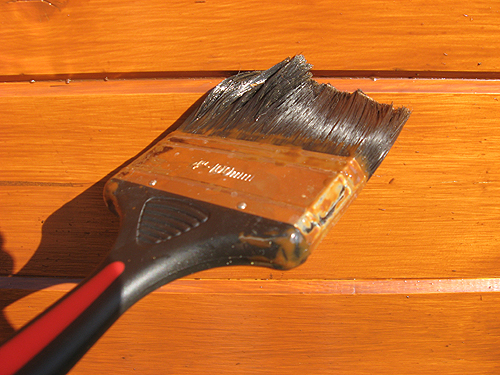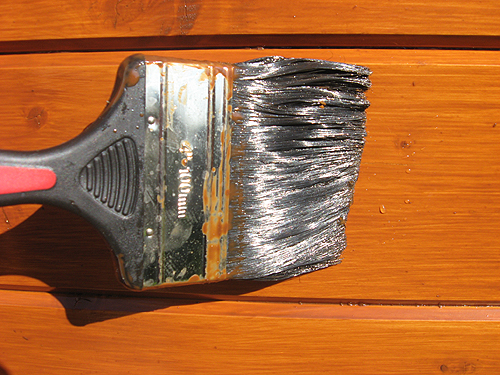How do I paint my new log cabin? It seems like a straightforward question, but assuming you want to paint it properly here’s some tips and advice.
It hardly needs saying but be sure at the outset in your choice of paint colour or whether you wish to use wood stain rather than paint. Wood stain gives a more ‘natural’ feel with the grain of the wood showing through and all the knots. If anything, wood stain makes a log cabin look even more like a traditional down-home, backwoods log cabin. With different paint applications, however, you can transform a log cabin into a seaside beach hut, a garden room or a modern home office.
You can even use combinations of paint colours to enhance the look and feel you are after, perhaps by highlighting window and door surrounds with a stronger colour than the background logs. Manufacturer’s brochures will give you some idea of the final result. Having said that, it’s a very good idea to test the wood stain or colour first on any leftover scrap log from the build.
Having made a choice of paint colour or wood stain it’s time to make sure the wood is thoroughly prepared. Hopefully you will have chosen to have your cabin pre-treated with wood preserver. Failing that, then hopefully you were able to treat all the timber with wood preserver before the build, paying extra attention to soak the exposed end grain. If it’s not pre-treated, you have another opportunity to treat the entire cabin (inside and out) with wood preserver.
Next, apply at least two coats of knot sealer to all the knots on any logs that you intend to paint over; this will seal in the knots and prevent any bleed through the final paint surface exposing areas which will then look bad and deteriorate faster.
Rub down with a fine grade of sandpaper any surfaces of logs which are rough to the touch. There should be none but it’s worth checking.
The first coat of wood primer paint or woodstain should be applied as soon as possible after assembly of the cabin. Once exposed to the elements the logs will discolour and start to split open especially in direct strong sunlight. Early paint application will provide the best protection. Choose a dry day but avoid if possible painting in direct sunlight or on excessively hot or cold days.
The best paint brush to use is a 10cm (100mm) wide brush suitable for gloss finishing. A good quality brush is a wise investment as it will give a better finish and should not shed bristles like the cheap ones. You cannot get a good finish with a bad brush. At 10cms width the brush will more or less match the logs.
It is crucial, as far as possible, to paint all exposed areas of timber. By starting to paint in the joints between the logs with the brush held sideways on you can be more confident of sealing these areas. Having loaded the brush for the joints between logs, you can then brush the faces of the logs with the brush held correctly and with the bristles less loaded with product. Use this method for the whole log cabin.
Now, sadly, some web-based log cabin retailers make fantastical claims about ‘their’ logs. They state that one coat of paint will be fine, or that wood preserver is hardly necessary etc. Their agenda, let’s remember, is selling log cabins. If you actually read the manufacturers instructions they all clearly state that wood preserver and proper treatment and paint application is vital for the longevity of the cabin. There really are no shortcuts here; treating the cabin is a long laborious process. Consider, spreading out the coats of paint or wood stain over the course of a summer, so as to spread the workload. But remember, if you treat the cabin right in the first place, you will have less and easier maintenance for many years to come.
As a rule of thumb you need to apply two coats of wood preserver, two applications of knot sealer, two base coats and two top coats. If you go for paint rather than wood stain you will need an additional coat of primer before the two undercoats. This is a lot of work even on the smallest of cabins, and if you are reading this prior to making a purchase and it sounds like too much effort, you might want to consider alternatives that require less maintenance.
Don’t forget also that you will need to rub down the logs lightly with fine sandpaper between each coat of paint to provide a key for the subsequent coat.
However for log cabin fans this is the correct way to paint or treat your new log cabin. Why not spread the job out over the summer months? If all else fails, consider a log cabin painting party and rope in friends and neighbours!

